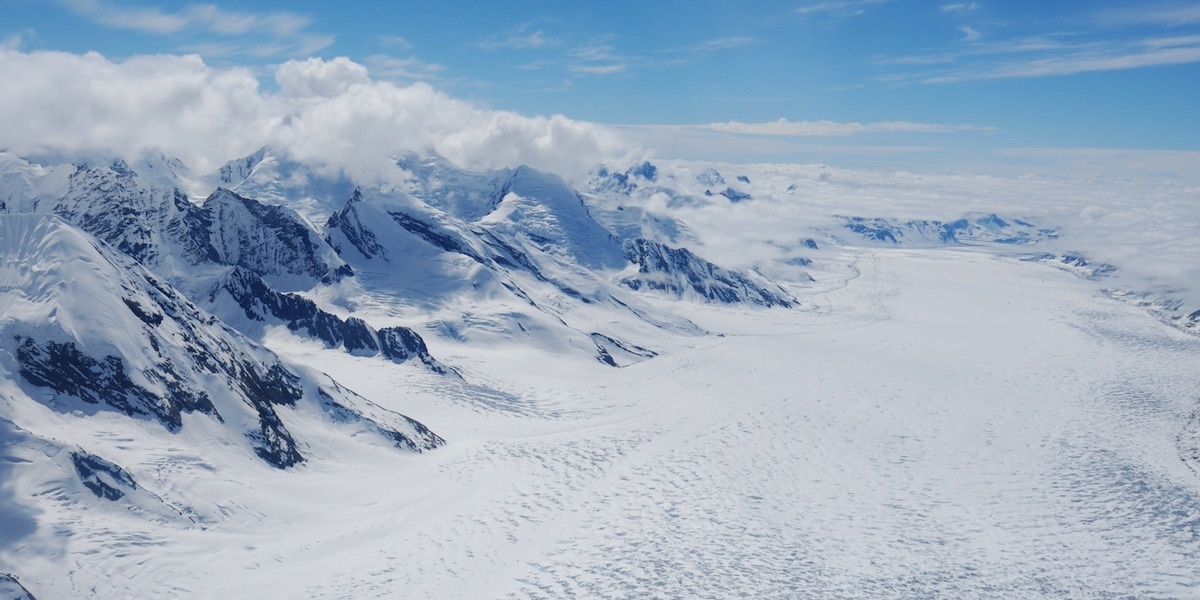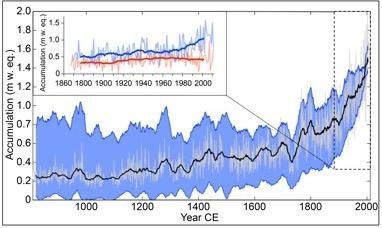

New research shows that the
Alaska Range receives an average of 18 feet of snow per year—that’s more than double the average of eight feet per year from 1600-1840.
The likely culprit, according to researchers from Dartmouth College, the University of Maine and the University of New Hampshire, is none other than
climate change.
“We were shocked when we first saw how much snowfall has increased,”
said Erich Osterberg, an assistant professor of earth sciences at Dartmouth College and principal investigator for the research. “We had to check and double-check our results to make sure of the findings. Dramatic increases in temperature and air pollution in modern times have been well established in science, but now we’re also seeing dramatic increases in regional precipitation with climate change.”
The Alaska Range, North America’s highest mountain range, is a 600-mile long chain of mountains that stretches from the Alaska-Canada border to the Alaska Peninsula. The range is best known for its largest mountain, Denali, and its namesake park,
Denali National Park and Preserve.
According to the research, snowfall during the winter has jumped 117 percent since the mid-19th century in Southcentral Alaska. Summer snows increased 49 percent in the same period.
The study, published in the journal
Scientific Reports on Tuesday, adds more evidence on the effect of climate change on regional precipitation. Earlier this month, an analysis published in the journal Environmental Research Letters found that human-caused warming likely intensified Hurricane Harvey‘s record rains over Houston.
For the current study, the researchers analyzed two ice core samples collected at 13,000 feet from Mount Hunter in Denali National Park.
The authors suggest that warmer waters from the tropical Pacific and Indian Oceans caused a strengthening of the “Aleutian Low” pressure system with its northward flow of warm, moist air, driving most of the snowfall increases.
“It is now glaringly clear from our ice core record that modern snowfall rates in Alaska are much higher than natural rates before the Industrial Revolution,” said Dominic Winski, a research assistant at Dartmouth and the lead author of the report. “This increase in precipitation is also apparent in weather station data from the past 50 years, but ice cores show the scale of the change well above natural conditions.”
Time series shows the dramatic doubling of snowfall around North America’s highest peaks since the beginning of the Industrial Age. Inset shows summer (red) and winter (blue) snowfall since 1870.Dominic Winski
Climate change refers to more than just changes in the average surface temperature. The term also describes variations in sea levels, sea ice and, yes, snow.
Here’s a simple explainer on how warmer temperatures can lead to more snowfall, straight from the U.S. Environmental Protection Agency:
Warmer temperatures cause more water to evaporate from the land and oceans, which leads to more precipitation, larger storms, and more variation in precipitation in some areas. In general, a warmer climate causes more of this precipitation to fall in the form of rain instead of snow. Some places, however, could see more snowfall if temperatures rise but still remain below the freezing point, or if storm tracks change.
Climate deniers have used the presence of snow to cast doubt on climate science. Remember Sen. James Inhofe of Oklahoma’s infamous snowball-throwing stunt on the Senate floor?
Also, check out this 2013 tweet from then-reality show host, now-
President Donald Trump, who thinks global warming is a “hoax”:
https://twitter.com/realDonaldTrump/statuses/412017385345138688

 233k
233k  41k
41k  Subscribe
Subscribe 
